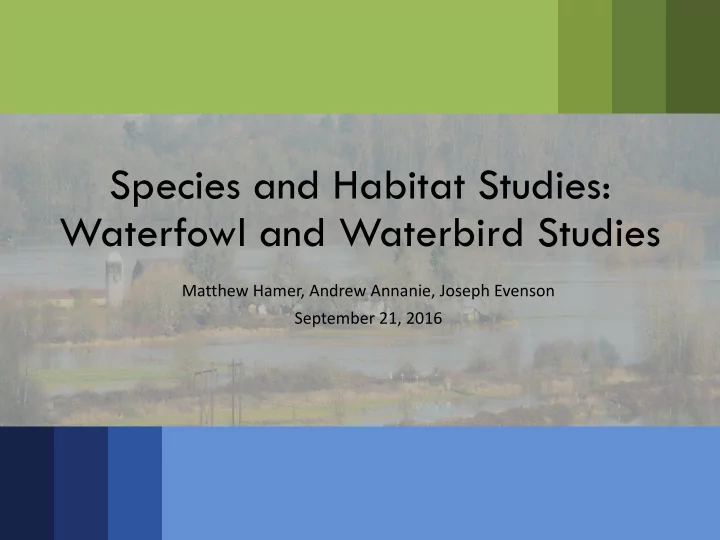

Species and Habitat Studies: Waterfowl and Waterbird Studies Matthew Hamer, Andrew Annanie, Joseph Evenson September 21, 2016
Study Objectives 1. Quantify waterfowl and waterbird use of aquatic off-channel habitats within the Chehalis floodplain 2. Derive estimates of waterfowl abundance, across temporal and spatial gradients, throughout the Chehalis floodplain 3. Document waterfowl production, within aquatic off-channel habitats, throughout the Chehalis floodplain 2
Overview Ground Surveys Aerial Transect Surveys • 36 400-m Wide Transects • 36 Off-Channel Sites • April 2015 • Wintering and Migration Survey (Breeding Period) • October 2015 o November 2015 – (Fall Migration) May 2016 • February 2016 • Production Survey (Early-Spring Migration) o May – June 2016 • April 2016 (Breeding Period) 3
Classifying Ducks Puddle Ducks Diving Ducks Sea Ducks 1. Mallard 1. Ring-necked Duck 1. Bufflehead 2. Green-winged Teal 2. Scaup (Lesser & Greater) 2. Hooded Merganser 3. American Wigeon 3. Canvasback 3. Common Goldeneye 4. Northern Pintail 4. Common Merganser 5. Wood Duck 5. Red-breasted Merganser 6. Northern Shoveler 6. Surf Scoter 7. Cinnamon Teal 8. Gadwall 9. Eurasian Wigeon 10. Blue-winged Teal http://lib.store.yahoo.net/lib/yhst-16688783476651/dabbling-duck-1.jpg https://s-media-cache-ak0.pinimg.com/236x/f8/82/82/f8828273b93798e46f4776c6dd2a2a37.jpg http://flyways.us/sites/default/files/images/stories/divingducks/1DivingDuck.jpg 4
Habitat Associations FORESTED AND SHRUB- HERBACEOUS SPECIES OPEN WATER SCRUB WETLANDS WETLANDS American Wigeon 0 − − + Green-winged Teal 0 − − + + Mallard − − − + Northern Pintail 0 0 + + Wood Duck + + + − Common Merganser + − − 0 Hooded Merganser 0 + − Common Goldeneye 0 − − − − Ring-necked Duck 0 0 + Scaup + + − − 0 Double-crested Cormorant 0 0 − − Pied-billed Grebe + − 0 5
Wetland Prairie 6
Floodplain Population Estimates 7
Generalist MALLARD DENSITIES (Km 2 ) 23 February 2016 Minimum 0 Maximum 286 Average 59 Spring Migration 8
Piscivores: Fish-eating Ducks COMMON MERGANSER DENSITIES (Km 2 ) 23 February 2016 Minimum 0 Maximum 68 Average 4 Spring Migration 9
Herbaceous Wetland Specialist NORTHERN PINTAIL DENSITIES (Km 2 ) 23 February 2016 Minimum 0 Maximum 124 Average 8 Spring Migration 10
Benefits of Winter/Spring High Water • Waterfowl use shallowly inundated (<10”) fields* o Primarily utilized by puddle ducks • Flood pulse lateral retraction/downstream movement o New feeding areas o Increased invertebrate production** o Increased access to grass seed and unharvested grain** * Fredrickson and Reid 1988 ** Bayley 1995; Fredrickson 1988 11
Benefits of Winter/Spring High Water • Inundation longer than 8 – 10 days allows for additional body mass gain ** • Late-winter inundation is more beneficial o Temporal proximity to spring migration** ** Heitmeyer 2006 12
Waterfowl Production # OF SITES # OF MEAN PRODUCTION SPECIES BROOD BROODS BROOD SIZE ESTIMATE (SD) PRESENT OBSERVED (SE) Mallard 13 of 36 30 4.5 (0.6) 763 (218) ( Anas platyrhynchos ) Wood Duck 9 of 36 18 4.2 (0.4) 137 (43) ( Aix sponsa ) Canada Goose 2 of 36 5 4.2 (1.0) - ( Branta canadensis ) Cinnamon Teal 2 of 36 2 6.0 (1.0) - ( Anas cyanoptera ) Hooded Merganser 2 of 36 3 4.3 (1.5) - ( Lophodytes cucullatus ) Blue-winged Teal 1 of 36 1 - - ( Anas discors ) Common Merganser 1 of 36 1 - - ( Mergus merganser ) Pied-billed Grebe 1 of 36 1 - - ( Podilymbus podiceps ) 13
Mallard Breeding Density MALLARD DENSITIES (Km 2 ) BREEDING AVERAGE Minimum 0 Maximum 25 Average 4 14
Wood Duck Breeding Density WOOD DUCK DENSITIES (Km 2 ) BREEDING AVERAGE Minimum 0 Maximum 8 Average 0.7 15
Canada Goose Breeding Density CANADA GOOSE DENSITIES (Km 2 ) BREEDING AVERAGE Minimum 0 Maximum 65 Average 3 16
Conclusion • Further analysis of this data set in conjunction with future habitat modeling is required to understand o Changes in off-channel habitats and possible changes in use o Differing levels of field inundation o The future role that climate change will play 17
Acknowledgments & Works Cited • Andrew Annanie • Ilai Keren • Kyle Spragens • Carol Cloen • Don Kraege • Julie Tyson • Tom Cyra • Warren Michaelis • Habitat Program’s Intensive & Extensive • Keith Douville • Debbie Moe Crews • Joe Evenson • Bryan Murphie • Private Landowners • Marc Hayes • Carol Powers • Hillsboro Aviation • Bayley, Peter B. "Understanding large river: floodplain ecosystems." BioScience 45.3 (1995): 153-158. • Fredrickson, Leigh H. "13.3. 1. Invertebrate Response to Wetland Management." (1988). • Fredrickson, Leigh H., and Frederic A. Reid. "13.2. 1. Waterfowl Use of Wetland Complexes." (1988). • Heitmeyer, Mickey E. "The importance of winter floods to mallards in the Mississippi Alluvial Valley." Journal of Wildlife Management 70.1 (2006): 101-110. 18
Questions ? 19
Recommend
More recommend